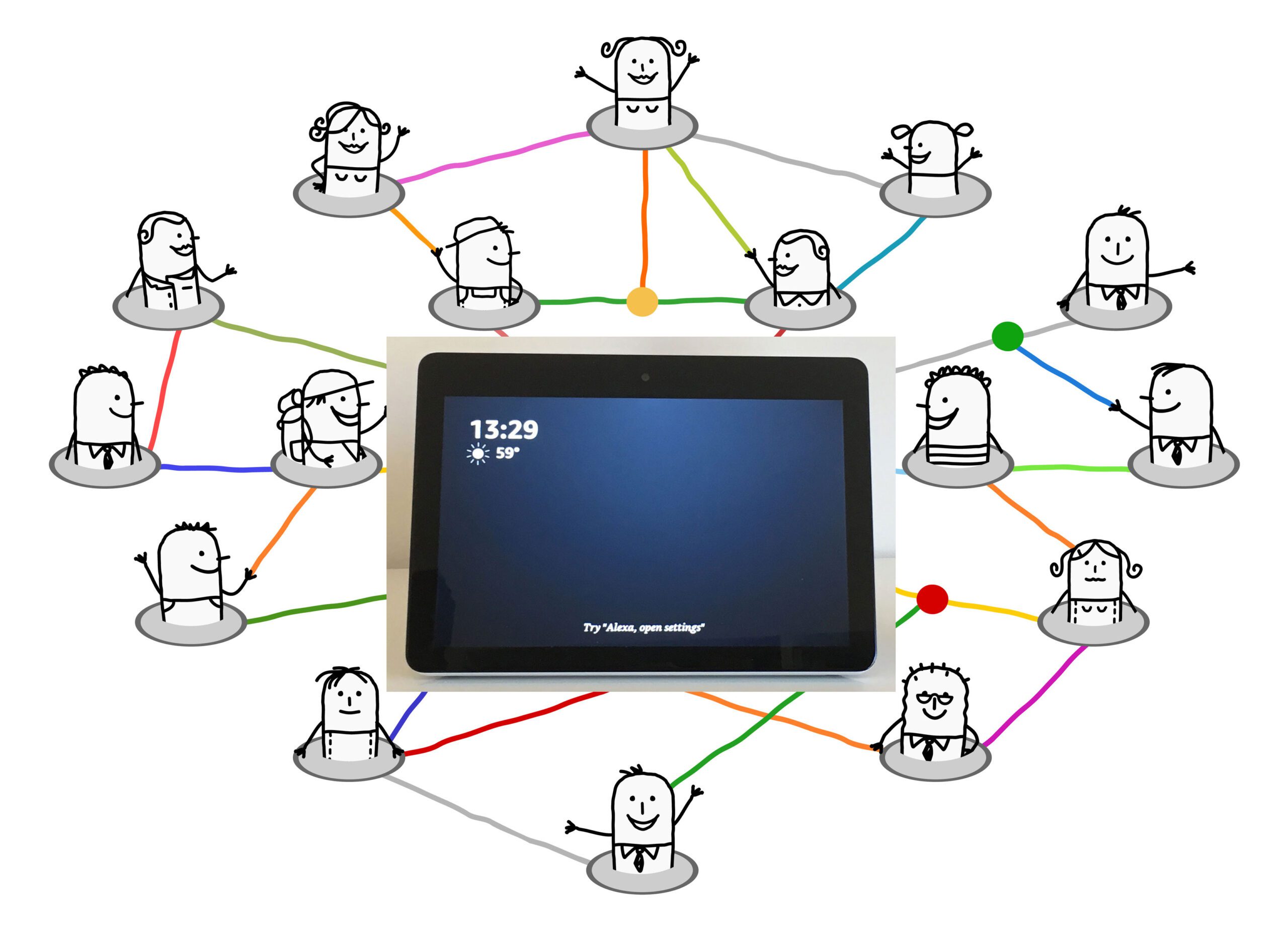By: Richard Caro | Posted: April 10, 2019 | Updated: April 5, 2023
Perhaps it seems counterintuitive that an artificial intelligence (AI) might help combat loneliness and isolation.
But as our Longevity Explorers evaluate the latest version of Alexa, paired with the Amazon Echo Show — which has an excellent video call capability — we are starting to see great potential for these products to do just that.
There are really two separate thoughts here.
1. There is the idea, getting a fair bit of media attention, that interactions between an older adult and an AI (Alexa) might help reduce isolation.
2. And then there is the idea that Alexa (an AI) can facilitate deeper human to human interactions (with friends and family for example) as well.
It’s this second idea we find especially intriguing.
Based on our recent explorations of Alexa and the Amazon Echo Show, we think it has real potential. But there are still some issues.
About Alexa and the Amazon Echo Show
Alexa is an artifical intelligence (AI) developed by Amazon, and made available in a family of hardware products with names like the Amazon Echo, the Amazon Echo Dot and recently the Amazon Echo Show.
For a general introduction to the Amazon Echo, and what our community of older adults (the Longevity Explorers) think of these products, and what they use Alexa for, see Amazon Echo and Alexa for the Elderly. And for our exploration of the Amazon Echo Show discussed in this article, see Amazon Echo Show: Older Adults Explore.
Alexa and Loneliness Interventions
Having an artificial intelligence to interact with is certainly cool, and many of our explorers find it very useful. But what if Alexa could also improve the depth and quantity of our interactions with our fellow humans?
The Levers for Impacting Isolation and Loneliness
Social Isolation and Loneliness are complex conditions, with a variety of contributing causes which vary greatly from person to person (listen to our Longevity Explorers digging into this topic further, and exploring causes and possible solutions in “Isolated and Lonely: How Can We Avoid This?“).
But there are several ways in which you can imagine Alexa can make a difference.
- Interactions directly with an AI (Alexa herself);
- Interactions with other humans — made easier or better or more frequent by Alexa.
And as far as interacting with humans is concerned, there are two subcategories we are going to discuss here:
- Deeper interactions with friends and family who live far away; and
- Making new friends; or finding acquaintances with the right interests or personalities.
Interacting with Alexa (an AI)
One of our Longevity Explorers, who has Alexa in several pieces of hardware in her home (Echo and Dot), is fond of saying:
“Alexa is my friend”.
This sort of comment is something we hear increasingly at our meetings of Longevity Explorers. It seems there are times when it is nice to have a friendly AI to talk to — and to have her play music; tell you about the weather; adjust your lights; and tell you a joke when you need to hear one.
Quite a few groups are studying the potential of interacting with Alexa as an intervention for loneliness in the elderly.
For example, AARP Foundation has a program for “Social Connectedness Voice-activated Technology“, which has a goal of determining whether technology of this type can help older adults fight isolation and loneliness (1). And Front Porch and the Consumer Technology Association Foundation are rolling out Alexa to senior living facilities in the hope of impacting loneliness and isolation via the Voice-activated Independence for Smart Home Engagement (VISHN) initiative (2).
As far as we can tell, these programs mostly involve humans interacting with Alexa, and we definitely think this is a great place to start.
But, as we recently explored the Amazon Echo Show, with its excellent video-call capability, we realized that there is now the potential for something even better than humans interacting with an AI.
Interacting with Other Humans (with Alexa’s Help)
When talking about Alexa and older adults, inevitably someone will say:
“But I don’t really want to talk to a machine. I want to interact more with other people.”
In it’s latest form, we think Alexa has the potential to help facilitate deeper, and more frequent, human to human interactions.
There are two aspects to the combination of Alexa and the Amazon Echo Show that get us excited about the potential for more (and better) engagement between older adults and their friends and family.
The biggest and most important capability is a super simple, video call capability. You just say “Alexa, call John” and (so long as you did the initial setup correctly), Alexa places a video call to the “John” you had in mind, and his face appears on the Echo Show and you can interact with him. (See a demo of this simple video call capability).
Making conventional phone calls, with a voice command, is equally easy — which can be important in scenarios where physical or mental imperfections might make it less likely that an older adult would make that phone call with more conventional technology.
By now, some of you are undoubtedly thinking:
- “I hate video calls”; or
- “I know how to make a phone call, thank you very much!”
But read on to see the reasons for our opinions, and feel free to comment at the bottom if you don’t agree with them.
Deeper Interaction with Remote Friends and Family
Many of us have close friends and family members who live somewhere sufficiently far away to make face-to-face meetings less frequent than we would like. What we really want is more (and or deeper) interactions with those distant friends and family members.
In my opinion, technology has a real role to play here.
I have observed that using the right technology to interact with friends and family at a distance can make the interactions deeper and more meaningful. And there is a sort of virtuous circle. Once the interactions become less stilted and more satisfying, people suddenly make it a higher priority to be available for them, and so you have more of them.
The problem is that the “perfect” technology does not yet exist, and the “best technology that does exist” is a bit too complicated for many people to want to use. There is a sort of adoption barrier, the height of which relates to how hard the technology is to use.
This is where we are excited about Alexa and her ability to help people make video calls (and to a lesser extent phone calls). Because she makes the “best available technology” for interacting at a distance quite a bit easier to use. And thus accessible to a broader range of people.
Video Calls: The Best Way (so far) to Interact at a Distance
Over 30+ years in which I have lived 7,000 miles away from my parents, sibling, and the friends I grew up with, I have tried out a wide variety of ways of staying in touch, and maintaining friendships. And as we discuss these topics in our Longevity Explorer meetings, I have found that many others have had similar experiences.
I know exactly what to me the “ideal product” is for interacting with my mother, who lives far away and is in her 80’s. I want some type of “robot” which lives in my mother’s house, and which I can use to do a remote visit. I want to be able to appear on it using some type of telepresence; be able to sit in her living room and share a chat and a cup of tea; and be able to follow her around the house so we can talk as she does other things. And I want it to be friendly enough in appearance and the way it acts to be acceptable to my mother, and to be fully under her control as far as when I can drop in and where I can go in her house.
Such products “almost” exist. I have tried out several and they are close. But various aspects make them not quite ready for this use case in my opinion.
However, I (and many others) have found that video calls are the next best thing for staying in touch — both with family members, and with friends and acquaintances. It seems there is a depth of connection you get with video that is just not there with a conventional voice call. And video calls seem to make it easier to just “hang out”, even if you don’t have a specific set of information to impart.
In our Longevity Explorer circles we have spent considerable time talking about video call capability, and having our explorers try out various video call products. This has reinforced my opinion that video is a really excellent way for people to get deeper interactions with their friends and families, although there are certainly some people who simply don’t like the idea of appearing on camera, even after they have learned how to do it.
But here is the problem. Today’s video call technology, while enormously better than in the recent past, is still intimidating to many of the older adults with whom we interact.
My personal current favorite (Facetime) is remarkably simple, and has excellent quality. And for a one on one conversation when both parties are comfortable using Facetime, I am not sure it can be improved on.
The potential for Alexa and the Amazon Echo Show is for the many people who are just not comfortable using Facetime, or are not in the Apple world (competitors like Skype are harder to use in my opinion), or don’t have a smartphone or a computer with a camera.
As we discuss further in our companion exploration “Amazon Echo Show: Older Adults Explore“, the big advantages of video calls on the Amazon Echo Show are the simplicity: “Alexa call John”. And the specific hardware implementation (all in one; no need for smartphone or computer; loud and high quality sound).
New Friends; Acquaintances with Shared Interests
A quite different challenge that many of the older adults in our explorer circles are interested in addressing is how to make new friends, or meet acquaintances who share common interests.
One of the challenges here for older adults is that the people who you can easily interact with (because they live close by, or attend the same church or Village meetings you do) are not necessarily the people who share your interests or have the personality traits that will make them your best friend.
In our society, older adults are often segregated by age, and the assumption is that you will want to hang out with others just because you are of a similar age. But what if you care less about a person’s age than about their interests or opinions or type of personality? And perhaps you have a hard time finding such people in your immediate circles.
This is where the idea of affinity groups becomes intriguing. Would it be interesting to be part of a group characterized not just by age, but by something you care about such as a common interest or shared experience?
There are already examples of ways to do this, of course. There are Meetups (3). And there are various online “meeting” sites, where you can make new friends. And we think these are excellent ideas.
But what if the Meetup you want to attend is too far away? Or if it is at night and you don’t like to go out at night?
Interact Remotely with a Group
This is where we are wondering if the Amazon Echo Show might play a role. We noticed that it seemed to work quite well when we used it to attend a remote meeting of our Longevity Explorers. Maybe this could be the tool that makes it easier to attend meetings remotely, opening up a new group of potential human-human interactions?
In the past, we have experimented with attending meetings remotely using various telepresence robots. Frankly, we found the results a bit disappointing. There usually seemed to be issues with sound quality and volume, and sometimes with picture quality, and often with the amount of WiFi bandwidth required for everything to run well.
We are not sure yet if the Amazon Echo Show addresses all these issues, but our initial tests looked promising.
And a big issue is price. The Echo Show is much cheaper (an order of magnitude) than any of the telepresence robots we have tried so far.
Some Issues
If you read this far, you can see we are quite bullish about Alexa plus the Amazon Echo Show as a potential tool to help fight isolation and loneliness.
But it is certainly not perfect. In our exploration “Amazon Echo Show: Older Adults Explore“, we created a partial list of the “issues and weaknesses” we observed with this product, and we are not going to repeat them all here.
In our opinion, the largest issue — especially for a target demographic of older adults — is the complexity of getting Alexa set up in the first place.
As we discussed this in our Longevity Explorer groups, it became clear that the vast majority of our explorers who had and liked Alexa had had someone else (usually a family member) set it up for them.
Maybe this is not a huge deal. But it would certainly be an excellent improvement if the setup process could be made simpler. As you might imagine, our Longevity Explorers had lots of views as to how to do this.
Conclusions
We think that the combination of a voice-activated AI — and the easy video call capability which that AI can facilitate on one’s behalf — might be a real game changer as we seek tools to reduce social isolation.
Time will tell if we are right, and we would love to hear your opinions. Please add your thoughts in the comment section below.
Notes:
1) While we formed these opinions while evaluating Amazon’s products Alexa and the Echo Show, we note that there are competing products too. Our opinions really relate to the whole class of AI assistants and video calling — although the specific hardware implementation is critical. We have not yet evaluated the competitors, so we can’t comment on whether they are better or worse than the Amazon products explored in this article.
2) We have no financial interest in the products discussed here, and this article is not sponsored or supported in any way by any product vendor. See How we Fund our Work.
References
(1) AARP Foundation: Social Connectedness Voice-activated technology program.
(2) Voice-activated Independence for Smart Home Engagement (VISHN) initiative.
(3) Meetups (Meetup.com)
*Disclosure: The research and opinions in this article are those of the author, and may or may not reflect the official views of Tech-enhanced Life.
If you use the links on this website when you buy products we write about, we may earn commissions from qualifying purchases as an Amazon Associate or other affiliate program participant. This does not affect the price you pay. We use the (modest) income to help fund our research.
In some cases, when we evaluate products and services, we ask the vendor to loan us the products we review (so we don’t need to buy them). Beyond the above, Tech-enhanced Life has no financial interest in any products or services discussed here, and this article is not sponsored by the vendor or any third party. See How we Fund our Work.


